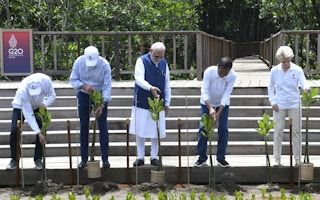India assumes G20 leadership at a time of multiple global crises marked by economic troubles, war and mounting climate impacts.
To continue reading, subscribe to Eco‑Business.
There's something for everyone. We offer a range of subscription plans.
- Access our stories and receive our Insights Weekly newsletter with the free EB Member plan.
- Unlock unlimited access to our content and archive with EB Circle.
- Publish your content with EB Premium.
The G20 represents more than 80 per cent of global GDP, 75 per cent of international trade and 60 per cent of the world’s population. As a strategic group, the G20 can and should play a leading role in facilitating the energy transition and rallying significant investment into both mitigation and adaptation. With India at its helm, equal emphasis can be expected on reimagining the role and phase-down of all fossil fuels as well as keeping the development priorities of emerging economies in mind.
The agreement to establish a loss and damage fund at COP27 this month demonstrated that even with intense disagreements raging through the two weeks, major economies of the world can come together towards a common global response that works for everyone. Political will is foremost. India’s vantage position in 2023 is a chance to build consensus on such hard-fought ideas that the world is faced with.
Here are five action points that India can prioritise for definite and swift gains:
Ramp up ambition for COP28
The world lacks neither the financial resources nor the technological capabilities to combat climate change. If we fail to prevent runaway climate change, it will be because we were unable to foster the political will to cooperate. “Our agenda will be inclusive, ambitious, decisive and action oriented,” Prime Minister Narendra Modi recently tweeted. As a narrative, this is well-intentioned and well-packaged. Using the G20 as a moment to reinforce a shared vision of climate action – importantly, among the major historical and big emitters of the world – and build a deep sense of urgency for action on climate change, will consolidate India’s position of ambition towards next year’s climate negotiations to be held in the UAE.
Rev up the phase-down of all fossil fuels
India’s call for phasing down all fossil fuels while ramping up clean energy to meet the energy needs of the future around the world, was both a political masterstroke and a well-intentioned strategy to make a case for reduced dependence on all fossil fuels—coal, oil and gas. However, as we saw at COP27, there was no agreement in the ranks of the developing countries on this proposal. After initial hesitation, both the EU and the US backed the proposal.
During its G20 presidency, India has an opportunity to steer the world towards the larger objective of curbing the use of coal, oil and gas, which remain the main causes of climate change. India also has the opportunity to champion a just energy transition while calling for a 100 per cent renewable energy future.
Champion more JET-Ps
Trumpeted as the first-of-its-kind solution to climate finance, the Just Energy Transition Partnerships (JET-Ps) have yet to see breakthroughs in new and additional funding to support a shift in energy use across the developing world. Developed countries are strained to provide the right kind of finance to help their developing counterparts shutdown coal power plants, retrain fossil workers, and protect affected communities.
Now, JET-P is a G7 instrument, which is applicable within the G20 and other developing countries of the world. With the incoming presidency of Japan for next year’s G7, it will be notable to see how the negotiations go forward. Japan has been a supporter of contentious climate solutions such as co-firing ammonia and hydrogen in the power sector. India was chosen as a JET-P partner, but progress has yet to happen. This is one area for India to keep an eye on as the world pivots to energy transition.
Speed up the overhaul of global financial systems
At the G20 in Indonesia, leaders gave a push to the reform of the international financial architecture, calling for restructuring debts of vulnerable economies in the face of growing debt distress and rising risk of sovereign debt defaults.
Building on the momentum for building a fairer and more sustainable global financial system, India could take the lead in creating channels for green finance at the G20. By creating processes and urging commitments to remedy the global community’s failure to do so at COP27, this could enable world leaders to approach the next COP with better possibility of success.
Make sustainable lifestyles trendy
Under the Mexican presidency in 2012, the G20 pursued inclusive green growth as a priority. In 2020, the Saudi presidency had circular economy as a key theme. Similarly, soon after making a commitment to LiFE, or “lifestyle for sustainable development” as part of its long-term strategy to decarbonise submitted at COP27, India could be the flagbearer for sustainable lifestyles across the G20 economies and around the world.
By replacing the “use-and-dispose” economy with a circular economy defined by mindful and deliberate utilisation of resources, India’s public think-tank NITI Aayog says, LiFE intends to nudge individuals to undertake simple acts in their daily lives that can contribute significantly to climate action when embraced across the world.
Aarti Khosla is founder and director at Climate Trends, a strategic communications initiative for climate action, and director at CarbonCopy, a climate and energy news website.











